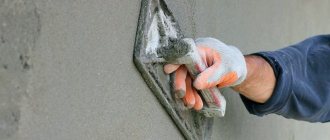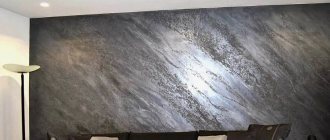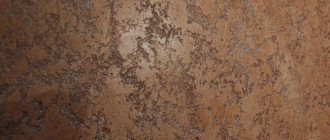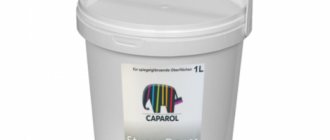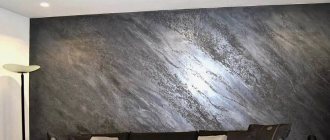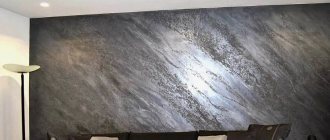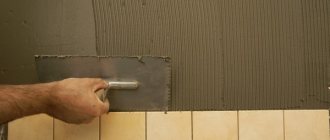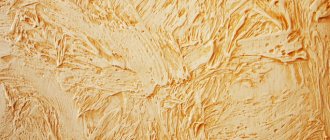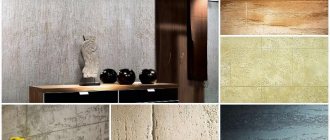Recently, many have begun to wonder what is better: wallpapering or decorative plaster on the walls? This choice is the basis for future repairs. Each option has both its advantages and disadvantages. In this article we will look at which option is better, and also tell you which decorative plaster is best suited for finishing a particular surface.
The benefits of wallpapering
Before you decide, you need to consider the pros and cons of the two options. So which is better? Let's start with the wallpaper.
They are extremely popular and are now known to everyone. Due to their practicality and low cost, they are used both in offices and in private homes. However, not everyone knows about the main characteristics. The advantages include:
- wallpaper is made from environmentally friendly substances that do not cause allergies and do not cause any harm to humans or animals;
- wallpaper is a good sound insulator, which gives it a definite advantage over other coatings. This material also does a good job of retaining heat in the room;
- gluing requires virtually no surface preparation. The material is able to hide minor imperfections in walls, such as unevenness or cracks. The only thing you need to pay attention to is the choice of high-quality glue;
- The wallpaper is soft and outperforms its competitors in beauty. This type of coating guarantees a large selection of design solutions;
- Even a beginner can hang wallpaper. The process is quite easy and does not require much effort or investment. This coating is quite cheap, so you won’t need any special financial expenses. The main thing is to carefully consider cutting the rolls and follow the instructions provided;
- the material has good permeability, which will provide protection against mold on the walls.
Bed along the wall - 7 ways to protect the wall covering from dirt and damage
The problems of residents of small apartments are often associated not only with how to arrange furniture so that there is still some free space left. It often happens that the size of the room does not allow you to purchase a luxurious bed with a headboard, and the covering of the walls behind the bed gets dirty over time, loses color and wears out.
In this case, renovating the apartment is expensive and not necessary at all. You can protect the covering of a small area in the immediate vicinity of the bed or decorate an entire wall adjacent to the sleeping area. This can be done in a variety of ways.
Varnish coating
Paper, non-woven, and photo wallpapers are most often the “weak link” in the bedside space. To protect this coating from dirt or abrasions, as well as to increase service life, they are coated with varnish in 2-3 layers. After this, you can safely wash the walls with water or detergent.
Application of liquid wallpaper
Adding varnish to the mixture when preparing liquid wallpaper will add additional shine. The range of colors allows you to choose a shade that will fit well into the interior. This type of covering is used in the area next to the bed because it has a number of undeniable advantages:
- moisture resistance;
- does not fade;
- safety (hypoallergenic);
- low maintenance (applied to different surfaces);
- possibility of additional decoration.
Zoning the bedside space
The protection of the wall covering near the bed will be fully ensured if this space is originally decorated using natural materials:
- silk-screen printing is expensive, but for the area near the bed you won’t need much;
- cork - soft elastic material that allows air to pass through;
- bamboo covering;
- wooden - a varnished product will emphasize the structure of the wood, protect it from moisture, drying and cracking. Laminate is also used instead of wood. If desired, you can finish the entire wall up to the ceiling or just its lower part.
Soft panels
The bedside space will be beautifully and reliably protected by decorative elements that will add zest and make the room more comfortable. You can order them in a store or make them yourself. To do this, cut out parts of the required size from plywood or chipboard, apply a soft base (foam rubber or padding polyester) and attach with a stapler. Then choose a material that suits the situation and also secure it with metal staples.
Soft pillows or tapestry
Soft pillows suspended on a bracket will perfectly protect wall coverings. You can make them yourself by choosing the fabric for pillowcases to match your interior.
For protection and insulation, a panel, an animal skin, or a patchwork rug, sewn or knitted yourself, are hung on the wall.
Finishing with decorative plaster
To protect the space near the bed, finishing is used that imitates various materials: brick, stone, marble. Plaster for indoor use is safe for health and is even suitable for decorating a child’s room.
Disadvantages of wallpapering
The disadvantages include the following:
- during the next renovation, it will be very difficult to remove wallpaper from the wall, since it has very strong adhesion to the wall thanks to the glue;
- they are difficult to clean from dirt. When interacting with water, the wallpaper may deteriorate. Recently, it is not uncommon to see special washable wallpaper, but it is also very difficult to clean;
- The coating is easily torn off by pets. Although this will not harm your pet, the wall will lose its presentation and the effect of the repair will quickly disappear;
- They cannot be glued in rooms with high humidity. Wallpaper will quickly deteriorate and peel off from the wall;
- Even with perfect repairs, this material will have to be replaced after 5-7 years. Wallpaper is not designed for long-term use, and those that can withstand it cost a lot of money;
- Even with slight interaction with a sharp object, the coating will tear.
MDF panels
Precisely MDF panels, and in no case chipboard! When choosing material for the bedroom, we rely on safe rest and sleep, and in the production of chipboard we use epoxy resins, which we obviously do not need. MDF material is more environmentally friendly, since the binder is taken from wood shavings, lignin is released as a result of heating and is safe for the human body.
The availability of the material and high imitation properties allow the use of MDF boards instead of expensive materials. What can fibreboard imitate? It can become an analogue of any type of wood and even stone, be of different colors, have a pronounced relief and texture. And all this can be purchased at an adequate price and easily installed in the apartment.
Several forms of MDF panels are used for walls:
- tiled,
- rack and pinion,
- leafy.
Advantages of decorative plaster
Treating walls with decorative plaster also has many advantages. Let's take a look at them in more detail:
- A huge variety of decorative effects will allow you to choose an option that will satisfy you personally. In addition, decorative plaster can imitate various stone coatings;
- it is suitable for both internal and external walls, for example, for finishing the facade;
- decorative plaster can be painted in the future, and it can withstand repeated repainting;
- the service life of plaster is much longer than that of wallpaper and can reach twenty years;
- decorative plaster is suitable for almost any style of cladding;
- the plaster has good adhesion and vapor permeability, which allows it to be used for finishing walls in the kitchen or bathroom without harming the coating;
- Quite high strength and weather resistance.
Now let's take a closer look at the cons.
Textile
The atmosphere created by fabric trim deserves special attention. The design of a classic bedroom uses fabrics with embroidery, printing and various patterns; in tandem with them, strict and laconic colors are often used, sometimes plain fabrics.
Cotton and linen are used for finishing, with rare exceptions or as a separate decorative element - furniture fabrics.
Let's be honest, the difficulty of gluing and the need for careful care are serious disadvantages, and many people opt for fabric wallpaper only in order to achieve the stylistic effect of a classic interior.
Disadvantages of decorative plaster
This material also has disadvantages. Let's look at them in more detail:
- quite high. You have to pay extra for high quality. In general, it is significantly higher than wallpaper;
- difficult process of applying decorative plaster. Here a beginner can no longer cope on his own, since certain skills and knowledge are required, as well as special tools;
- if an error is made during processing, the coating may subsequently crack or simply fall off;
- to apply decorative plaster, you need to first level the surface with ordinary cement- or gypsum-based putty;
- a long procedure for drying the solution, which can take up to several days.
Cork covering
We have already talked about cork wallpaper and noted its excellent characteristics, and now we will focus on cork panels. Advantages inherent in this coating:
- environmental friendliness and ease of care of the canvas - dust does not accumulate on the surface, which is important for the bedroom,
- ease of installation and lightness of the material against the backdrop of excellent strength and wear resistance,
- high insulating qualities.
Flaws? Alas, the main disadvantage of natural cork is its high price!
Main selection criteria
The choice of coating is influenced by a huge number of factors. First of all, you need to take into account personal tastes and the quality of the walls. Let's consider the main criteria when choosing wall finishes:
- The first and, perhaps, the most important criterion is the budget allocated for repairs. If you don’t plan to invest a lot of money in repairs, then it would be better to opt for wallpaper. They are cheaper compared to decorative plaster. Also, for the second option, you will need to additionally prepare the wall and, most likely, seek help from specialists, which will greatly affect the final cost of the repair;
- It is worth considering the period for which the repair is planned. If you like to frequently update the design of your room, then wallpaper is better. Conversely, if renovations are planned for many years, plaster will be the best option. If treated properly, it can last for more than ten years;
- It’s also worth deciding whether you can handle the repairs alone or whether it’s better to use the help of a construction team. Don't forget that wallpapering is much easier than applying decorative plaster.
Advice!
Keep in mind that if you plan to decorate the walls externally, decorative plaster has a clear advantage. As a result, it is important to note that the choice of coating does not greatly affect the beauty of the room. All factors are of a purely practical nature. Ultimately, the choice depends on your personal preferences, tastes, or expectations for your renovation. The style in which you want to renovate may also influence your choice. For a classic style, the best option would be wallpaper with patterns, and for a modern style, both finishing options are suitable. As an option, you can use a combined finish with different colors. It is also worth taking into account the furniture that will be installed in the room.
Tips for beginners
Many, having heard a lot from friends about the difficulties of working with plaster, begin to doubt their own abilities and deny themselves the pleasure of making repairs with their own hands. These tips will help you make the right decision:
- prepare the walls correctly, be sure to seal the cracks and coat the entire surface with primer;
- apply the solution from top to bottom;
- the plaster layer should not be larger than the size of solid inclusions;
- start working with simple types of plaster, for example, bark beetle.
The main problem for beginners is that they, without having sufficient application techniques, take on the creation of complex structures. And when you can’t achieve the desired effect, you lose the desire to ever work with decorative finishes. To avoid a negative experience, practice application on a separate area, for example, on a piece of plywood. This way you will feel more confident and get a lot of pleasant emotions from working with finishing materials.
Which plaster is better
There are quite a lot of decorative solutions for walls and each of them has its own advantages. It is impossible to answer unequivocally which one is better suited for the wall. So let's look at each option and analyze its characteristics. So, decorative plaster can be:
- Venetian When finishing the wall, it imitates a stone coating or fabric. It is often used specifically for interior cladding, but there are varieties that are used for exterior work. The solution is distinguished by its quality and strength, and it is also capable of providing a long service life, which can reach twenty years. The mixture has a high vapor permeability rate, so it is often used for walls in the kitchen or bathroom;
- bark beetle This plaster has a rain effect and is very popular for wall treatments. The bark beetle is chosen for exterior work and occasionally for interior walls. The mixture is of high quality and has good protection from frost, moisture and sunlight;
- mineral. Special stone chips are added to this mixture, which allows you to achieve a decorative effect. It can be used for both internal and external wall cladding.
As you can see, the choice of plaster depends on your preferences and type of work. If you plan to decorate the walls internally, it is better to use Venetian mixture, and for external work - bark beetle or mineral solutions.
Wood paneling
Country style is increasingly found in the work of designers, so natural wood has every right to be considered as one of the materials worthy of attention.
The lining is made from natural wood. Usually these are pine, larch, spruce, oak, which look great and feel good in the interior of a modern apartment. Here are the advantages of wooden lining:
- environmental friendliness and naturalness. A pleasant bonus is a pleasant aroma and the creation of an optimal microclimate for vacationers in the bedroom,
- external data. Thanks to a large selection of wood species, trunk textures and wood palette, you can choose what you like,
- ease of installation, durability and good insulation properties.
Tip: before installing lining in the bedroom, be sure to treat the wood with special pest repellents!
An economical option for budget renovation is the use of plastic lining with a texture and palette similar to wood, but for a bedroom this is not the best solution. Firstly, it doesn’t have the strength that its wooden counterpart offers, and secondly, it’s difficult to call it environmentally friendly, you’ll agree.
Conclusion
It is quite difficult to answer unequivocally which type of finish is best suited for walls. Wallpaper and decorative plaster have their own strengths and weaknesses. You should rely on your financial situation and type of interior. Plaster will allow you to achieve greater sophistication, however, more money will be spent on it. We recommend watching the following video to fully understand what is better for walls: wallpaper or decorative plaster:
Recommended Posts
Curtain accessories
3d wallpaper for living room + photo
How to properly glue wallpaper onto drywall with and without putty...
How to hang wide wallpaper
Beige wallpaper in the interior
Brick wallpaper in the hallway and corridor
Features of use in the bedroom
Source: //akademiya-decora.ru
What effects can be achieved in the bedroom by applying plaster:
- clouds;
- imitation tree bark;
- wavy sandy sand;
- leather-like texture;
- water drops;
- surface of the planet.
The effects may vary. Almost everything is appropriate in the bedroom. You can achieve an unusual effect by applying decorative plaster and emphasizing with acrylic paint the convex elements, their upper or side parts.
For small rooms, it is better to choose light plaster, which has a large texture or other decorative elements. Fine sepia and dark shades are more typical for the partial design of large bedrooms.
Color combinations are quite easily achieved by using several pastel tones.
Examples:
Source: //goopos.net
- beige and brown;
- peach and light pink;
- azure and heavenly.
White, brown, gray are considered universal tones, with which it is easy to create successful combinations.
For bright rooms with light, light-transmitting curtains, it is better to choose soft shades of plaster. Cool green, cool blue, neutral gray are not just desirable, but recommended.
How to apply marble Venetian plaster on the ceiling and walls with your own hands?
The working surface under Venetian plaster must be cleaned and leveled, because under the layer of such finishing the slightest errors are visible.
- Start finishing by priming the wall or ceiling; alternatively, apply 2 layers of acrylic paint.
- After the primer or paint has dried, we begin to apply the plaster. Divide the surface into squares 0.5 square meters wide. m.
- Apply the decorative mixture, you can even use different shades, in strokes. Then level it, smooth it into a square and polish it with wax.
Variety of textures
Depending on the plaster filler and application method, the surface may look like:
- sand wall or dunes;
- orange peel;
- luxury tanned or cracked leather;
- fish scales;
- various reliefs;
- reptile skin;
- smooth or fleecy fabric;
- semi-antique;
- cracked stone surface;
- precious stones.
USEFUL INFORMATION: How to plaster a wall with cement mortar with your own hands
Particular sophistication of the interior is provided by bas-reliefs that can be applied to a dried plastered surface.
What effects can you create?
Creating a decorative coating using plaster is a pleasure.
By combining a certain type of material, tool and application technique, you can achieve the stunning effect of craquelure, travertine, imitation wood or brickwork.
When creating it, they use manual cutting of dividing strips between stones on slightly “set” material. Gray color will enhance the similarity and give the room aristocratic restraint. Imitation of cracked leather or craquelure is gaining popularity. It is noteworthy that to create such an effect you will not need any effort at all: the material, after drying, “cracks” on its own, forming a pattern. Concrete-like plaster will fit perfectly and emphasize the style of factories.
Color palette
When choosing the color of the coating, where the bedroom windows face is also important. For example, if the room is located on the sunny side, then it is recommended to give preference to light colors. In a bedroom with this arrangement, a blue, green or gray shade will look great (depending on the interior).
If the windows face the north side, then orange, coffee or beige plaster is optimal for finishing. Bedroom walls finished in burgundy will also look great.


